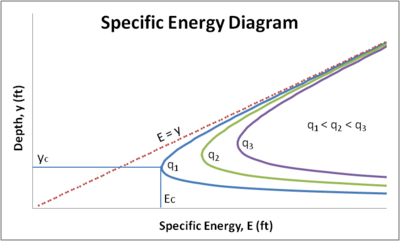Question
In: Mechanical Engineering
a) Describe the specific energy. b) In the rectangular duct, analyze the flow (Q) as a...
a) Describe the specific energy.
b) In the rectangular duct, analyze the flow (Q) as a function of depth (y) for constant specific energy (E = E0).
c) Define critical depth (yc) and critical speed (Vc) for this case.
d) Plot the flow (Q) - depth (y) graph and show the regimes of the flow.
Solutions
Expert Solution
(a)
Specific energy of a liquid in an open channel is the total mechanical energy of the flow relative to the bottom of the channel.

As we can see from the image, the specific energy is the energy compared to the bottom of the flow.
(b)
The below graph shows the relation between depth y and specific energy E for different flows, q1, q2, and q3.

At a constant specific energy, it is clear that flow increases as depth increases.
(c)
When the flow reaches a minimum value of specific energy, this point is called the critical point. The value of depth at this particular point is called the critical depth. The specific energy at this point is termed as the critical energy, and the velocity of the flow at this particular point is called the critical velocity.
In the above graph, the critical point of the flow q1 is given at the values of energy and depth are given as Ec and yc respectively.
(d)
The same graph can be used for plotting the flow vs depth graph. The different flows are given with the q1, q2, and q3 curves.

Related Solutions
Flow enters a heated duct at v1 = 2000 m/s, T1 = 300 K, and q...
Briefly describe what a duct blowers function is as it applies to residential energy audits
A smooth rectangular duct 300 mm by 400 mm carries air at a rate of 1...
A rectangular channel of bottom width B = 7 m carries an average discharge of Q...
At a point in a circular duct with inner diameter of 0.200 m, the flow is...
A high-viscosity oil is transported through a wide rectangular duct of length L, width W and...
1) Choose a characteristic of turbulent flow below. A) Laminar flow B) Produces kinetic energy C)...
what is false about the collecting duct? a. they are permeable to urea b. they are...
Air (280 K and atmospheric pressure) enters a 3-m-long rectangular duct (0.15 m by 0.075 m)...
Air at 5 bar and 560K is expanded in steady flow in a horizontal convergent–divergent duct...
- Q. WHAT IS THEORY X AND THEORY Y? Q. IF YOU HAD YOUR OWN COMPANY, WOULD...
- The world post Covid 19 has created the concept of social distancing which will impact on...
- Convert into pseudo-code for below code =============================================== class Main { public static void main(String args[])...
- If the density of the universe great than a critical value, then it might continue expanding...
- A 16.4-kg block rests on a horizontal table and is attached to one end of a...
- Freud’s theory of defense mechanisms has had a profound impact on the methods used by therapist,...
- discuss what a disclaimer is, when is it is issued, and how it would affect the...
 samet mamat answered 10 months ago
samet mamat answered 10 months ago